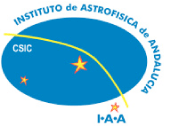Discriminating between hazy and clear hot-Jupiter atmospheres with CARMENES
In a recent study, we used the CARMENES spectrograph on the Calar Alto observatory to provide new insights into the aerosol presence in distant gas giants.
By analysing seven transits of HD 209458 b and HD 189733b, observed from the 3.5 m Calar Alto telescope, we scrutinised these hot Jupiters using high-resolution spectra. Employing a principal com ponent analysis algorithm (SYSREM), we disentangled the planet's signals from other contributions, such as the Earth's telluric absorption and the respective host star's contribution. We searched for the presence of water vapour in the atmosphere of these two exoplanets across optical and near-infrared wavelengths. We detected strong optical water vaopur bands at 5.2σ in HD 209458 b, whereas no evidence of these optical bands emerged in four transits of HD189733 b. However, both hot Jupiters show equivalent water vapour signals in the near-infrared. That is, the relative strength of the optical water bands compared to those in the near-infrared were found to be larger in HD209458 b than in HD 189733b.
ponent analysis algorithm (SYSREM), we disentangled the planet's signals from other contributions, such as the Earth's telluric absorption and the respective host star's contribution. We searched for the presence of water vapour in the atmosphere of these two exoplanets across optical and near-infrared wavelengths. We detected strong optical water vaopur bands at 5.2σ in HD 209458 b, whereas no evidence of these optical bands emerged in four transits of HD189733 b. However, both hot Jupiters show equivalent water vapour signals in the near-infrared. That is, the relative strength of the optical water bands compared to those in the near-infrared were found to be larger in HD209458 b than in HD 189733b.
We interpret this result as being due to the presence of high-altitude hazes in the latter planet, which are largely absent in the former. This is consistent with previous measurements with the Hubble Space Telescope. We showed that currently available CARMENES observations of hot Jupiters can be used to investigate the presence of haze extinction in their atmospheres.



